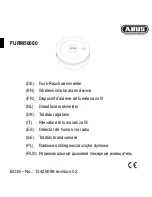
– 22 –
– 23 –
Radio controlled projection alarm clock with indoor climate
B 2:
Symbol indoor temperature
B 3:
Time/indoor temperature
C: Buttons (Fig. 2+3):
Top:
C 1:
SNOOZE/LIGHT
button
C 2:
Projection HIGH/LOW/OFF
button
Front:
C 3:
ALARM
button
C 4:
CALENDAR
button
Back:
C 5:
–
button
C 6:
SET
button
C 7:
+
button
D: Housing (Fig. 3):
D 1:
Battery compartment
D 2:
Power supply connection
D 3:
Projector arm
D 4:
ROTATE
dial
5. Getting started
5.1 Getting the projection alarm clock started
• The projection alarm clock can be operated with 3 x 1,5 V AAA batteries (not
included). The batteries maintain the clock operation in the event of blackout or
other power failure. In pure battery operation, the backlight is briefly activated with
the
SNOOZE/LIGHT
button and the projection with the
Projection HIGH/LOW/OFF
button. For a permanent backlight and projection and to conserve battery power,
use the supplied power adapter.
• Fold out the projector arm. Insert the power adapter pin into the device jack and
connect the plug to a wall socket.
• The device is ready for use.
• The device will alert you with a beep and all LCD segments will be displayed for a
short moment.
• Optional: Open the battery compartment and insert three new AAA 1.5 V batteries,
polarity as illustrated. Close the battery compartment.
5.2 Reception of the DCF frequency signal
• The clock will now scan the DCF frequency signal and the DCF symbol flashes.
Radio controlled projection alarm clock with indoor climate
• When the time code is successfully received after 3-10 minutes, the radio-con-
trolled time and the DCF symbol will be shown steadily on the display. If the recep-
tion fails, scanning stops and will be repeated every 2 hours.
• The DCF reception always takes place at 1:00, 2:00 and 3:00 o'clock in the morn-
ing. If the signal is not successfully received, further attempts will be taken at 4:00
and 5:00 o'clock.
• You can also activate the DCF reception manually. Press briefly the
SET
button in
normal mode. The DCF reception symbol will be flashing.
• Press the
SET
button again to stop the reception process. The DCF reception sym-
bol disappears.
• There are 3 different reception symbols:
flashing symbol - reception is active
solid - reception is successful
no symbol – no DCF reception
• If the clock cannot detect the DCF-signal (e.g. due to interference, transmitting dis-
tance, etc.), the time can be set manually.
• The clock will then work as a normal quartz clock (see: “Manual settings”).
Note on radio-controlled time
• The time is transmitted from an atomic clock near Frankfurt am Main by a DCF-77
(77.5 kHz) frequency signal with a range of about 1,500 km. Your radio-controlled
clock receives the signal, converts it and always shows the exact time. The adjust-
ment of Daylight Saving Time and Standard Time is also automatic.
• Avoid being close to possible sources of interference that may affect radio reception
(see “Location and mounting”).
• During night-time, the atmospheric interference is usually less severe. A single daily
reception is adequate to keep the accuracy deviation under 1 second.
6. Operation
6.1 Manual settings
• Press and hold the
+
or
–
button in setting mode for fast mode.
• Press the
SNOOZE/LIGHT
button to quit the setting mode. The device will automati-
cally quit the setting mode if no button is pressed for 10 seconds. The device will
automatically use the settings you have made so far.
6.2 Manual setting of the clock and calendar
• Press and hold the
SET
button for three seconds to enter the setting mode.
• The language setting (default: DEUTSCH=German) flashes on the display.
• Press the
+
or
–
button to select the language: GERMAN - DEUTSCH, ENGLISH,
SPANISH - ESPANOL or FRENCH - FRANCAIS, while the display flashes.
• Confirm with the
SET
button and go to the next setting.
TFA_No. 60.5017_Anl_09_22 21.09.2022 10:33 Uhr Seite 12













































